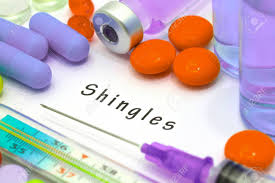Shingles is an infection caused by the varicella-zoster virus which is the same virus that causes chickenpox. Even after the chickenpox infection is over, the virus may live in your nervous system for years before reactivating as shingles. Shingles may also be referred to as herpes zoster.
This type of viral infection is characterized by a red skin rash that can cause pain and burning. Shingles usually appears as a stripe of blisters on one side of the body, typically on the torso, neck, or face.

Symptoms:
The signs and symptoms of shingles usually affect only a small section of one side of your body. These signs and symptoms may include:
- Pain, burning, numbness or tingling
- Sensitivity to touch
- A red rash that begins a few days after the pain
- Fluid-filled blisters that break open and crust over
- Itching
Some people also experience:
- Fever
- Headache
- Sensitivity to light
- Fatigue
Pain is usually the first symptom of shingles. For some, it can be intense. Depending on the location of the pain, it can sometimes be mistaken for a symptom of problems affecting the heart, lungs or kidneys. Some people experience shingles pain without ever developing the rash.
Most commonly, the shingles rash develops as a stripe of blisters that wraps around either the left or right side of your torso. Sometimes the shingles rash occurs around one eye or on one side of the neck or face.
Causes:
Shingles is caused by the varicella-zoster virus — the same virus that causes chickenpox. Anyone who’s had chickenpox may develop shingles. After you recover from chickenpox, the virus can enter your nervous system and lie dormant for years.
Eventually, it may reactivate and travel along nerve pathways to your skin — producing shingles. But, not everyone who’s had chickenpox will develop shingles.
The reason for shingles is unclear. But it may be due to lowered immunity to infections as you grow older. Shingles is more common in older adults and in people who have weakened immune systems.
Varicella-zoster is part of a group of viruses called herpes viruses, which includes the viruses that cause cold sores and genital herpes. Because of this, shingles is also known as herpes zoster. But the virus that causes chickenpox and shingles is not the same virus responsible for cold sores or genital herpes, a sexually transmitted infection.
Who is at risk for shingles?
Shingles can occur in anyone who has had chickenpox. However, certain factors put people at risk for developing shingles.
Risk factors include:
- being 60 or older
- having diseases that weaken the immune system, such as HIV, AIDS, or cancer
- having had chemotherapy or radiation treatment
- taking drugs that weaken the immune system, such as steroids or medications given after an organ transplant
Complications
Complications from shingles can include:
- Postherpetic neuralgia. For some people, shingles pain continues long after the blisters have cleared. This condition is known as postherpetic neuralgia, and it occurs when damaged nerve fibers send confused and exaggerated messages of pain from your skin to your brain.
- Vision loss. Shingles in or around an eye (ophthalmic shingles) can cause painful eye infections that may result in vision loss.
- Neurological problems. Depending on which nerves are affected, shingles can cause an inflammation of the brain (encephalitis), facial paralysis, or hearing or balance problems.
- Skin infections. If shingles blisters aren’t properly treated, bacterial skin infections may develop.
Prevention:
Two vaccines may help prevent shingles — the chickenpox (varicella) vaccine and the shingles (varicella-zoster) vaccine.
Treatment:
There’s no cure for shingles, but medication may be prescribed to ease symptoms and shorten the length of the infection.
Medications prescribed are varied:
| Type | Purpose | Drug frequency | Method |
| anti-viral medications, including acyclovir, valacyclovir, and famciclovir | to reduce pain and speed recovery | 2 to 5 times daily, as prescribed by your doctor | oral |
| anti-inflammation drugs, | to ease pain and swelling | every 6 to 8 hours | oral |
| narcotic medications or analgesics | to reduce pain | likely to be prescribed once or twice daily | oral |
| anticonvulsants or tricyclic antidepressants | to treat prolonged pain | once or twice daily | oral |
| antihistamines, such as diphenhydramine (benadryl) | to treat itching | every 8 hours | oral |
| numbing creams, gels, or patches, such as lidocaine | to reduce pain | can be applied as needed | topical |
| capsacin | to help reduce the risk of a nerve pain called post-herpetic neuralgia, which occurs after recovery from shingles | can be applied as needed | topical |






